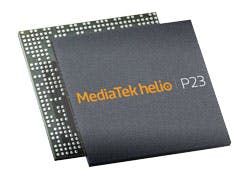Smartphones continue their upward climb in terms of performance and features while trying to stay within a mobile power envelope. MediaTek’s Helio X30 targeted the high-performance market, but the mid-range market could be even more interesting as high-end features become standard in this space.
Its latest Helio P23 (see the figure) and Helio P30 systems-on-a-chip (SoCs) are designed to give a boost to the mid-range market. Both are based on an octacore ARM Cortex-A53 cluster running at 2.3 GHz with an ARM Mali-G71 MP2 GPU. The P30 has a higher-performance, 950-MHz GPU capable of handling 2160- by 1080-pixel displays. Both SoCs manage h.265 encode and decode at 30 frames/s, with the P30 adding VP9 support.
MediaTek’s CorePilot support addressing scheduling and power management for CPUs and GPUs within the systems. This includes dynamic task management in a big.LITTLE approach, as well as handling multiple cores of the same type in an energy-aware framework. CorePilot 4.0 adds user experience (UX) to the scheduling mix.
The Helio P23 and its sibling, the Helio P30, are built around an eight-core ARM Cortex-A53 cluster running at 2.3 GHz.
On the memory side, the chips support 1600-MHz LPDDR4x up to 6 GB. Non-volatile storage interfaces include eMMC 5.1 and UFS 2.1.
The SoCs also differ in camera support capabilities. The P30 supports dual 16-Mpixel inputs or a single 25-Mpixel camera. Video-recording resolution is 3840 by 2160 pixels at 30 frames/s. The P30 also has a video-processing unit (VPU). The 500-MHz VPU has a real-time depth engine that works with a wide and telephoto lens system that can handle 10X optical zoom. The camera control unit (CCU) provides instant automatic exposure (AE) support. In addition, EIS 3.0 support provides digital image stabilization.
The chips are designed to work with a range of connectivity options, including LTE Cat-7 DL/Cat-13 UL with dual SIM support as well as CDMA2000 1x/EVDO Rev. A (SRLTE), FDD/TDD LTE, and HSPA+. They also handle Wi-Fi 802.11ac a/b/g/n/ac, Bluetooth, GPS; there’s also FM radio support.
Furthermore, the Helio P30 incorporates an always-on sensor hub unit based on an ARM Cortex-M4F. The Cortex-M4F has a floating-point unit and a 512-kB L2 cache. It maintains Android N Hi-Fi sensor support and can handle a range of sensors, including 9-axis accelerometer/gyro/magnetometer and pressure and ALS/PS sensors. It provides support for sensor fusion that operates at a much lower power level than the main cluster.



